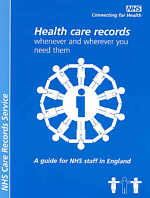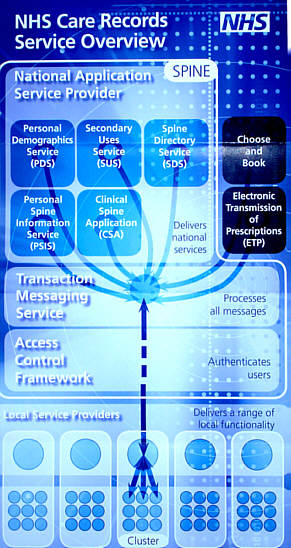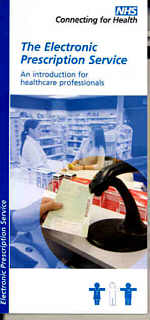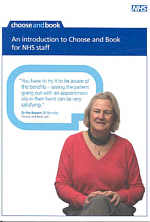|

- Changes, improvements, in CfH thinking is bests shown by the development of GP Systems of Choice
- The original articles on Connecting for Health and further background is here
In 2007 further developments and more pragmatic approach is developing. Parliamentary Health Committee is considering progress to date (click to link)
CfH, Connecting for Health, pushed the
following themes:
1. It is essential that there is a single NHS record, so health
workers
can use a common system: The need for a single global healthcare record
is a statement of
fact that cannot be challenged.
2. Patients already assume we share such data and are
disappointed to
know that we do not.
3. Up to 80% of computerised records are lost between
practices.
Of the "lost record" argument, there is the GP2GP system coming up, a
programme that was started before Connecting for Health, and it will
transfer the electronic records between practices. Currently
printed out paper backups do go
into the paper notes, while practices manually edit (cull) the records
for
the important facts, and any readcoded items such as "had chat to
patient" left
out, to avoid clutter. So "lost" is not quite the word, and who says it
is a bad thing to do so? Culled and edited is
more the point. There will not be any culling and editing of the
NHS
record, although there may be "sealed envelopes" for patients
confidential material.
Information Anywhere for
Clinicians: Is that always a good thing?
Connecting For Heath trumpets the idea is that if you attend a hospital
or a G.P. elsewhere, the
doctors and nurses would have access to a single summary care
record. We have done without such access for aeons. A
telephone call the next day irons out any real
difficulties about a
patient's history. It seems obvious at first sight, that if you
enter
casualty
staggering about the place, that the hospital doctors should be able to
see your clinical records of your G.P. and the records of any other
hospital you
have attended. Surely would save time and effort for the team to
be
able to read, from
anywhere in the UK your old records? That is in fact a risky
thing to do.
Doctors, on seeing a new
ill patients must start afresh, take a history and examine the
patient.
There
are risks in relying on previous diagnoses and computer entries.
To do so would
make us lazy, and closes open minds. One day a patients staggers
into
casualty with slurred speech. The casualty doctor would, it is
hoped,
read on the Integrated Care Record that the patient has an alcohol
problem, according to the (teetotal) G.P.'s clinical
record. Assured by that, the casualty doctor parks the patient in a
corner to sober up.
Alas the patient was staggering about because he had a small
stroke, or that he had cerebellar problems from undiagnosed low
thyroid
levels, or was even developing meningitis.
"Mistaken Identity" was a conference at LSE 19th May 1994. We
heard
from Paul Whitehouse, the former Chief of Constabulary of Sussex, an
example of how IT can get
in the way of thinking on your feet, an essential clinical skill, which
INCREASES risk. My summation was thus:
Before
"IT" a constable would have to think on his feet. A PC stops a
car acting oddly, such as going through a red light. The
constable
had no
access to any data systems. He asked the passengers and drivers a
few questions, and then, whilst keeping them seated, the PC opens the
boot. Should the passengers not have mentioned, nor explained the
fishing
rod in the boot, it would suggest the car was not theirs.
In Spain a few years ago a car was stopped, but thanks to
modern IT the car registration could have been checked before the car
had even come
to a halt;
it was not stolen, it was a hired car, a fact confirmed by the
passengers and driver. The driver's and passengers' ID
cards could be checked on the spot, and all checked out on the central
computer;
none of them was a wanted man. The car is allowed to go on; the
police comforted by
the IT data. It was a shame that they did not look in
the boot, as that contained the Semtex that blew up the trains in
Madrid.
I now see that my memory of his telling of it I
now see is not quite accurate. I found the whole speech is
here.
In
medicine we are dealing with biological, and
fast changing systems. We need to start again when we see
patients, especially in an emergency, and NOT be biased by what was
written before. All working to the same record may have benefits,
but also huge risks ESPECIALLY, in the emergency situation.
Nobody in Connecting for Health sees that. There benefits to the this
clinical intervention and there are risk as well, like any medicine,
drug or procedure. Global access to
records is seen as always as good thing, but there is no clinical trail
to prove that. It is an assumption.
It would be nice, for starters, that there was a single accessible
record
WITHIN each hospital or institution.
The recording of Allergies: An
example of the
complexity of the task.
It also seems obvious that a hospital doctor should know, from
anywhere
in the country, that a patient is allergic to a drug. But
that simple idea turns out to be a complex task. What is
allergy? It could just be a rash when once when given penicillin
as a child. But that rash may
have been due to the viral infection at the time. Collapse and
anaphalaxis... that's what I mean by allergy. Or do we mean
intolerance...such
as upset stomach with an antibiotic such as erythromycin.
But in a life saving
situation one would not like to avoid using a drug just because the
patient did not like the colour or the tablets and was vaguely coded as
"allergic" to it
on a previous occasion. How we record allergies and what we
mean by them is complex. For a G.P. using his computer, in his
surgery, allergy recording is a method to get his clinical system to
help the surgery team avoid
upsetting the
patient again by giving medicine X. For a hospital doctor that
same
information will have to be taken as an injunction NOT to give the drug
under
any circumstances, as they would assume that there is a high risk of
collapse or death if the patient was given the drug. Data
on G.P. computer systems were collected
for use within the surgery. To use this data for a different
purpose, that is creating a National data
set to be used by others without knowledge of the patient, adds an
astonishing level of complexity of the
task.
Incorrect entries
The next problem about a summary national record is the question
just who has the "root"
permission to delete an incorrect entry? The answer is
nobody at all can do that. What must be done add another line to
state the
line
above, or
referring to the one of many lines above was
wrong. A patient wrongly diagnosed as allergic to
penicillin
has to have another entry to say the opposite. Currently the Read
coding system does not cater for this. Negatives, incorrect entries are
deleted. The
is no "NOT"...read code. I am not sure how
negatives are to be put on the system at all. Some
practices used to put in codes such as H33 asthma and then in free text
adding excluded. Well of course the systems pick up the code as
asthma, the patient has asthma. There is no code !H33 meaning NOT
asthma. On G.P.
clinical system we can delete the entry (there is an audit trail to say
one did so) but the NHS care record will not allow that to occur.
I am still not sure how this has been resolved. SNOMED, a new coding
system may have a negation function.
Run before we can walk.
The first thing is to have electronic records within each institution
working properly. The Connecting for Health team dismiss the bits of
NHS IT that
work as "Digital Islands of Care". G.P.s account for
over 80% of NHS care, and ALL G.P.s computer systems on their
desks. We use them very effectively, as G.P.s have recently
demonstrated with high quality of care scores (QOF). That QOF
data
was
uploaded centrally automatically from our "legacy" systems. The
G.P. "digital island" they refer to, is a vast continent, representing
the largest clinical usage in the world. Only now is it being
admitted by the Connecting for Health teams that General practice
remains aeons ahead of the rest of the service, and that the Connecting
for Health should not destroy that which is working well.
Even
now there
are some excellent accredited G.P. system suppliers that do not have a
home on
Connecting
for Health's Local Service Providers, and could not be used by
G.P.s. G.Ps still do not have a full choice of system.
Still many hospital and community practitioners are not using
clinical systems, and consultants in hospital use and losing paper
records. Communications within hospitals are not there yet.
Common User Interface Across NHS.
This seems a good idea. With the NHS having a huge staff
turnover, and as staff moving hospital, it seems reasonable to have a
common look and feel to the NHS systems from wherever you are. It would
reduce training costs. However G.P. have very low turnover,
seldom move surgeries, and
their staff are loyal. There is a training component
to get used to idiosyncratic G.P. clinical systems, the speed at which
the
staff can operate one that is done, is faster than on systems that do
not require training to use.
The interface to systems is the most complex part of
software. It determines the speed of operation. What SELLS
a
product is the speed at which users can believe they are using
it. That leads to the use of mice and drop down menus....but for
busy clinicians those interfaces are no good. We must keep eye
contact with the patient, not look at where the mouse is pointing.
The NHS Common User Interface has two components. It is based on XP and
the
latest version of Office, the latter will be tweaked to have medical
term checking and medical spell checker. Other NHS functions my be
in-built.
The next is to have a framework on which a common interface for all the
hospital and clinical systems can use. The risk of that strategy
is
that it will set the NHS IT in aspic. There will be no new
interface designs possible. No new ideas will be able to
bubble up from the bottom.
Will the
Connecting For Health programme be swept away by outside change in
technology? It would only take the likes of google to
invent a medical care record service and that would be that!
Choose and Book
This was a good idea. The booking bit is for certain. The choice
is a
bit of a hot potato although it is a political imperative. Practice Based Commissioning on the other hand has
a remit to restrict
choice, and use "Care Pathways" and redirect patients from hospital
services. There is a clash of policy between choice and practice
based
commissioning. G.P. "off tariff" providers will not be allowed on
C&B.
It is a good idea that G.P.s could book patients in to outpatient
clinic direct form their desk, so both the doctor and patient know
there is an appointment in the system. The trouble is the
interface to do that is GHASTLY: It is back to front. When
booking a
flight on the internet one chooses the flight, and THEN book it and
THEN put in one's
name and card details. The NHS demand the name NHS number and
details FIRST, and checked, and then fight though drop down windows and
much mouse
clicking (there are no quick keys or shortcuts) does the doctor find
that the
department they both chose, does not do on-line booking....7
minutes into a
consultation.
There is another advantage of C&B, in that it is more secure and
private method of
making referrals. That is true. The data is encrypted, the
letters read by
clinicians. At the conference it was stated an
average of 22 people handled a standard written G.P. referral from G.P.
to hospital
doctor, and all could if bothered read the letters. It strikes me
that there
is a staffing problem in the NHS if that is the case.
At the conference the Connecting for Health team members that I spoke
to seemed to
agreed with the following:
1. The bandwidth of the current broadband connections (256K uplink) is
not wide enough for G.P.s to use hosted systems. The plan is that all
G.P. systems will be centralised and served from data centres. This is
the NHS
"solution" All data should be held off site, and not remain in
G.P.s surgeries the moment it is typed in. The cheat that some
working systems use is to have some form of local server, and store and
forward the data. Connecting for Health LSPs remains opposed to
local servers.
2 G.P. systems are fast, and the only clinical systems used
in front of patients. The UK still leads the way in this field,
with 100% of practices with working clinical systems from 10 suppliers,
four main suppliers left. Destroying what we have is now seen as
madness. G.P. systems are now being looked at as a basis for the
Microsoft £40M common clinical interface. It looks as if
the best ideas of current
systems will be thefted in this way (Microsoft has seldom been credited
with inventing new concepts...just taking over others).
3 The Choose and Book interface is a mess. In all the
propaganda and leaflets you see smiling clinical looking at screen with
pointing mouse and drop down menus. At last the interface team
recognise that use of mice in a clinical situation SLOWS YOU DOWN.
Practical problems: The lack of
help
lines.
The Connecting for Health team present at the conference were
not surprised by my experience of using Connecting for Health
systems. We
now use swipe cards that authenticate who we are. The software
that does this is complex. It installed (we are not on
version 4) on the practice computers, except on two machines. One
these machine every software component was there but one part not was
talking to the
next. There is no real technical help line. It is not up to
one's
clinical system supplier, as the software is not theirs. The Local
Service Provider does not talk to
G.P.s directly, the PCT did not know the answer. There is no national
email help, nor a sensible discussion group with a
few techies on board.
Even the Connecting for Health technicians working on the project
suffered similar issues. After many phone calls and emails the official technical Connecting for Health
answer to
my problem came as follows: Wipe
the
disc and re-install windows XP, office and clinical interface, re-map
drives, re-install sophos spyware, dns,gateway, etc etc..
That was the dumb advice from a multi-billion contract: There is
nobody you can contact who knows the code, the registry entries or
anything. There is no board or chat room to converse and exchange such
information. The failure on some
machines for NHS authentication to install is a well known problem
(especially for machines that have
been
upgraded to XP). I spent all afternoon un-installing the the
Connecting for Health products and then removing every reference to the
components in the registry, and re-installing it It worked then,
but I have no idea which line that needed removing, that got the
beast to work. Nor it seems does the multi-billion Connecting for
Health
organisation know or care. Us G.P.s are mere pawns, and ignorant
ones at that,
so cannot be talked to on such matters.
I came away from the conference a little less depressed about
Connecting for Health. After £Millions wasted, it looks as
if the intense antagonism against Primary Care and G.P. working current
clinical systems
has been diluted. However the Local Service Providers, who have
to host these clinical systems, were not present at this conference.
The Local Service Providers still insist, for their own commercial
reasons, on pushing
their preferred monolithic mouse driven systems, working off site,
using the NHS
256k uplink. Those systems were often conceived in
America, where clinical use by doctors in front of patients in
surgeries is rare, except for
billing.
Gerard Bulger



